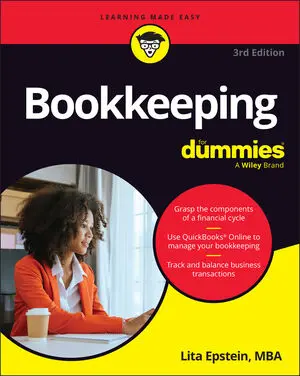Articles & Books From Bookkeeping
Concise, easy-to-understand information on every aspect of bookkeeping Bookkeeping For Dummies is a clear guide to tracking transactions, figuring out balance sheets, keeping ledgers or journals, creating financial statements, and operating accounts for businesses. This necessary resource offers relevant, up-to-date tax information and small business laws, so you'll have everything you need to conquer small business bookkeeping tasks.
Cheat Sheet / Updated 07-14-2025
Bookkeepers manage all the financial data for small companies. Accurate and complete financial bookkeeping is crucial to any business owner, as all of a company's functions depend on the bookkeeper’s accurate recording of financial transactions.Bookkeepers are generally entrusted with keeping the Chart of Accounts, the General Ledger, and the company journals, which give details about all financial transactions.
All the essential financial skills you need to grow a small businessBookkeeping & Accounting All-in-One For Dummies, UK Edition, 2nd Edition simplifies every aspect of financial record keeping so you can manage your business expertly. You'll receive comprehensive guidance on balancing your books, speeding up data entry, and boosting performance by eliminating costly clerical errors.
Cheat Sheet / Updated 09-05-2023
To stay organized and on top of your nonprofit’s bookkeeping and accounting responsibilities, timely complete accounting tasks need to be done daily, weekly, quarterly, and yearly.Keep necessary financial information up to date so you’re prepared to submit paperwork to your independent certified public accountant (CPA), the government, and all stakeholders, both within and outside your nonprofit organization.
Cheat Sheet / Updated 04-17-2023
There are several steps to understanding bookkeeping and maintaining a good record of your business’s finances throughout the year. It’s advantageous to get your head around the trickier bits of keeping the books and to know the process in order to better check and control those incomings and outgoings.Double-entry bookkeepingIn double-entry bookkeeping you enter all transactions in the books twice: once as a debit and once as a credit.
Cheat Sheet / Updated 04-07-2022
A great bookkeeper cares that the financial statements make sense and gets upset when something doesn’t balance or stuff goes missing. They also feel responsible when it comes to getting customers to pay on time. A good bookkeeper, in other words, is worth their weight in gold.This Cheat Sheet summarizes what you need to know to be an excellent bookkeeper.
Cheat Sheet / Updated 02-25-2022
The title of bookkeeper brings up mental images of a quiet, shy individual who spends countless hours poring over columns of numbers. In reality, the job of a bookkeeper is of vital importance to any business that needs to account for its assets, liabilities, and equity. From the company founders to the investors to the IRS, the bookkeeper must be able to report the financial status by way of balance sheets and income statements and keep an organized and detailed paper trail of every financial transaction.
Cheat Sheet / Updated 02-25-2022
Bookkeepers take care of all the financial data for businesses. Accurate and complete financial bookkeeping is crucial to any business’s decision makers: owner, outside investors, creditors, bank and even its employees. Keeping a close eye on your day-to-day business operations can help you be a Canadian small-business success story.
Article / Updated 03-17-2021
You’re probably not interested in just breaking even. You want to make money in your business. But knowing what quantities you need to sell just to cover your expenses is often super-helpful. If you own a one-person accounting firm (or some other service business), for example, how many hours do you need to work to pay your expenses and perhaps pay yourself a small salary?
Get across the bookkeeping basicsManage GST and customer invoicingGenerate financial reportsLearn the basics and take the stress out of bookkeeping!Whether you're new to the world of bookkeeping or looking for a refresher on bookkeeping fundamentals, this is the book for you. From information on how GST works through to recording everyday transactions and creating reports, this straightforward, jargon-free guide will break down the basics of bookkeeping and help you keep the finances of any business, no matter how large or small, on the right side of the ledger.





